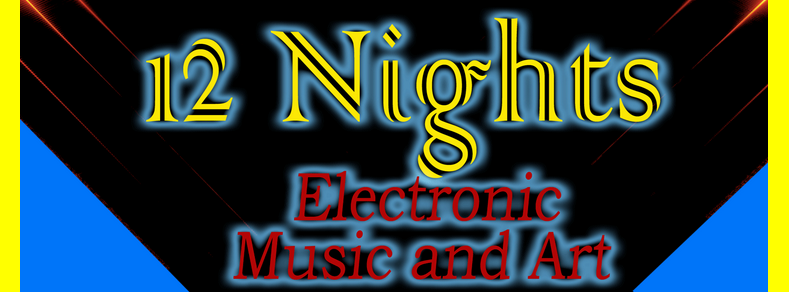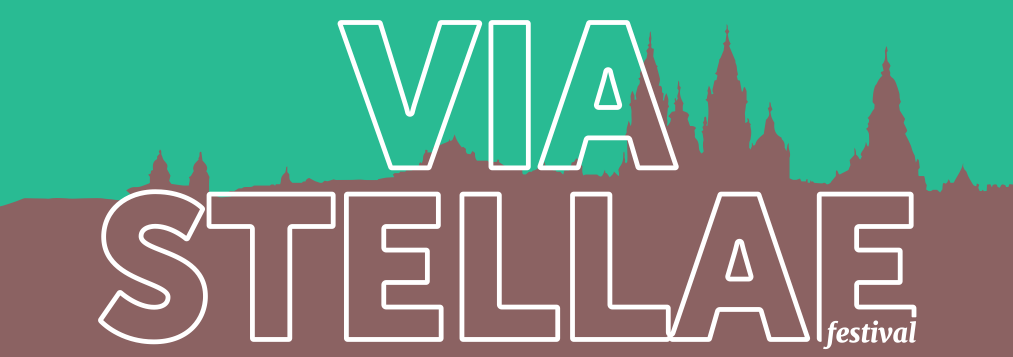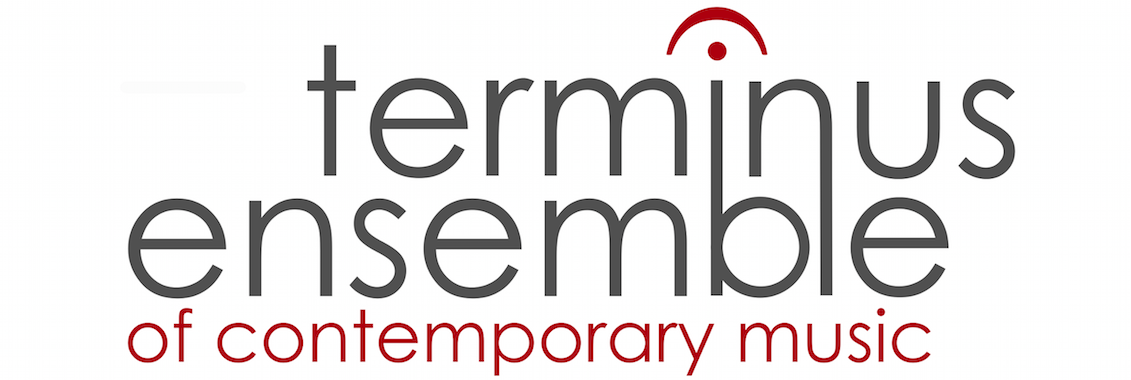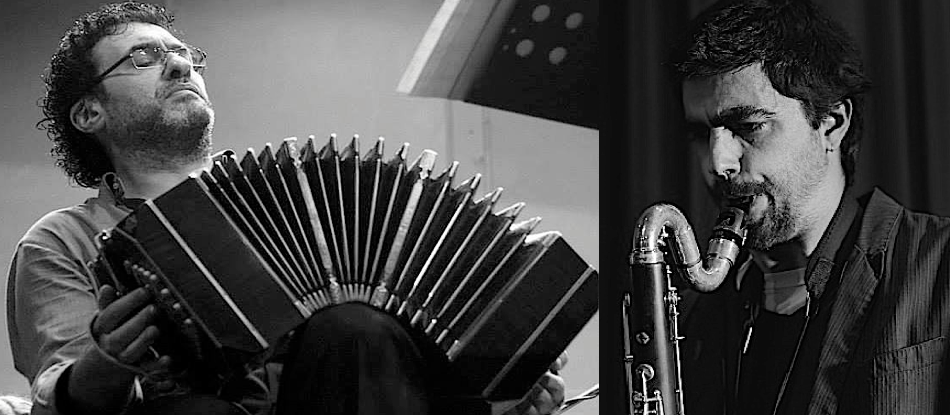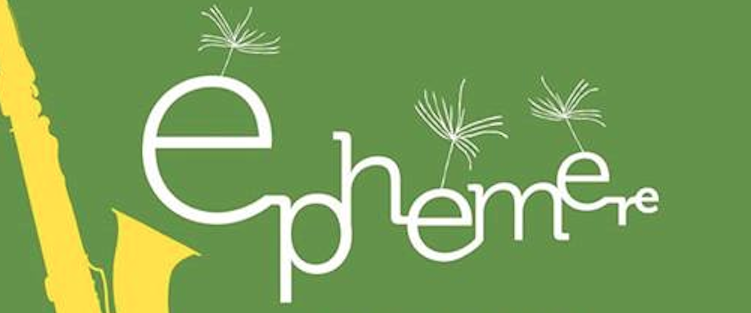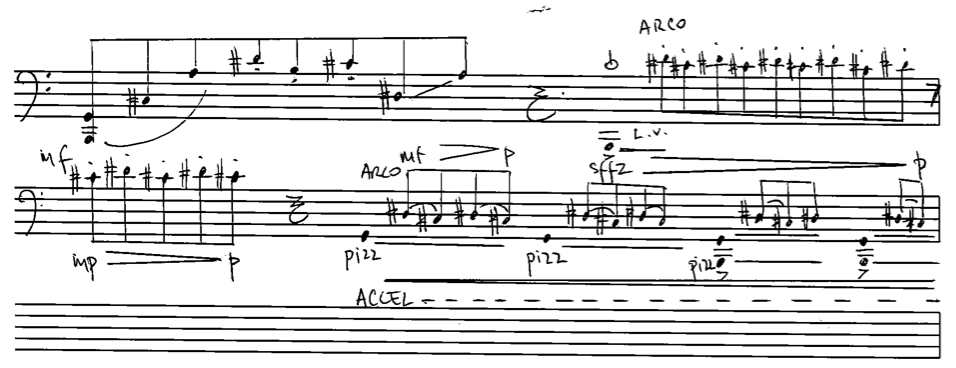On October 2nd and 3rd I will be presenting a repertoire electroacoustic music by Latin American composers at Florida International University and at the 12 Nights Season at the Harold Golen Gallery.
Category Archives: Audio and scores
Roberto Oliveira – Kableado in Santiago de Compostela
Kableado
es un programa de percusión, electrónica y arte visual, con altas dosis de improvisación, que busca generar un ambiente propicio para el entendimiento de estas nuevas tendencias en el arte sonoro y
fomentar el interés por la música electroacústica. Con instrumental de percusión convencional (vibráfono, cencerros…) y no convencional (piedras, agua, madera, metal…), Kableado reúne obras  de Andrés Àlvarez (Galicia), María Mendoza (Galicia), Raúl Tudón (México), Jorge Variego (Argentina) y Diana Pérez y Reyes Oteo (Andalucia), concibiendo un universo de nuevos sonidos, texturas y sensaciones. Arte sonoro y nuevas tendencias de la mano de Roberto Oliveira, alquimista audaz y vanguardista, centrado en la interpretación de nuevas técnicas, recursos instrumentales renovados y aspectos escénicos inusuales, motivado por el enriquecimiento y renovación del concepto y la experiencia del concierto como un todo.
de Andrés Àlvarez (Galicia), María Mendoza (Galicia), Raúl Tudón (México), Jorge Variego (Argentina) y Diana Pérez y Reyes Oteo (Andalucia), concibiendo un universo de nuevos sonidos, texturas y sensaciones. Arte sonoro y nuevas tendencias de la mano de Roberto Oliveira, alquimista audaz y vanguardista, centrado en la interpretación de nuevas técnicas, recursos instrumentales renovados y aspectos escénicos inusuales, motivado por el enriquecimiento y renovación del concepto y la experiencia del concierto como un todo.
Performance: July 10th
Two studies for bass clarinet available at Tutto Musik
Terminus ensemble at UT – February 17th 2015
Terminus Ensemble of Contemporary Music was founded in 2011 to promote new classical music by composers based in Atlanta, Georgia. Terminus was the original name of Atlanta – it was the end of the line for the Western & Atlantic Railroad. But Terminus does not literally mean “the end.” Rather, it means “boundary.” Our ensemble focuses on music made by natives and residents of Atlanta, but we also seek to explore the boundaries of art music.
Alvin Lucier Orchestral works – CD review
ALVIN LUCIER Orchestra Works. Diamonds for 1, 2 or 3 Orchestras. Slices. Exploration of the house • Christian Arming, Petr Kotik, Zsolt Nagy (cn); Charles Curtis (vlc); Demarre McGill (fl); Andrea Overturf (ob); Anthony Burr (cl); Valentin Martchev (bsn); Benjamin Jaber (hn); John Wilds (trp); Kyle Covington (trb); Jonathan Piper (tb); Jeff Thayer (vln); Jisun Yang (vln); Che-Yen Chen (vla); Yao Zhao (vlc); Jeremy Kurtz-Harris (db) ; Janácek Philharmonic Orchestra • New World Records 80755-2 (76:04)
Alvin Lucier’s music arises my most primitive curiosities. When I listen to his work, all the technicalities seem not to be relevant anymore, I only want to know how those sounds have been built, how the composer fabricated all the forms, sounds and textures. I experience a sort of sensorial challenge: is Lucier’s work meant to be touched or seen?
In Diamonds for 1, 2 or 3 Orchestras (1999) Lucier becomes a painter. Using the orchestra as his palette, the composer creates sonic shapes that move in space. Unisons, glissandi, and a split ensemble are some of the orchestrational resources that trigger the listener’s imagination. It is clear that the work is about the aural representation of diamond shapes, but the connections between sound and shape could remain hidden to the inattentive ear. The trajectories, forms, and colors of the aural bodies challenge our basic act of listening raising another fundamental question: do we really listen to this work or we look at it?
The middle track of the disc, Slices for cello and orchestra (2007), is anything but a traditional cello concerto. In fact, the cellist is more of a magician with a four-stringed wand than a soloist. The 53-note cluster (probably coming from the syntonic temperament) that reigns throughout the work covers the whole playing range of the solo instrument and is orchestrated in a way that every note is assigned to a different instrument of the ensemble. The compositional process is simple: with each note that the cello plays, an instrument of the orchestra (the one that plays that same note) becomes silent. Essentially, the music goes from cluster to silence and from silence to cluster. The process is clearly revealed but yet magical. This procedure repeats—not identically—for seven times until the work ends in silence.
In Exploration of the House (2005) Lucier revisits the feedback paradigm of I am sitting in a room in which he explored the resonances of the enclosed spaces. However, the sound source of the work is not the composers’ voice, but a selection of seventeen short fragments from Beethoven’s The Consecration of the House overture performed by the Janácek Philharmonic. Far from being self referential, the piece proposes a multi-layered homage: it celebrates Beethoven and Haydn’s meta personalities that slowly evaporate in front of a static orchestra. Interestingly, the climax arrives with utmost subtlety, in the very moment when the orchestral excerpts become unintelligible and the resonances of the concert hall take over.
Lucier’s Orchestra Works is not a regular album. With only three tracks, the CD unfolds the inner ear, constantly challenging the most primary act of listening. The sounds offered are not just for aural intake, they can be touched and seen.
Close your eyes and enjoy a world of multicolored tangible sonorities.
“Brujerías” for solo piano in a new album!
Click on the image to get access to the full pdf version of the Album.
or visit this link:
http://www.musicalis.es/?product=album-xxv-aniversario-de-musica-y-educacion
Soloist with the Mayo chamber orchestra
Algorithmic composition seminar at UNR
Plataforma 37 en Rosario
Este viernes 11 de julio a las 21 Biblioteca Argentina – Pje. Alvarez 1550 – , con entrada libre y gratuita se presenta el dúo “Plataforma 37”, integrado por Luis Caruana (bandoneón y composición) y Jorge Variego (clarinetes y composición) con repertorio propio. Esta es su segunda función después del debut, hace 7 días. Organiza Secretaría de Cultura y Educación de la Municipalidad de Rosario.
El dúo “Plataforma 37” adoptó ese nombre porque “Después de muchos años, nos encontramos en esa plataforma (en Retiro) y ahi empezamos a gestar la idea del dúo”, nos contó Jorge Variego.
At studio Loos with the Domino kwartet on 05/15 at 20:30!
Domino kwartet
Omiros Miltiadous – drums
Francesco Saccheti – guitar
Ignacio Santoro – double bass
Jorge Variego – reeds, compositions
///
Wos#x: (re:de)form No. 2 – a composed space for two percussionists
Mei-Yi Lee – percussion
Chi-Hsia Lai – percussion
///
EFT
Ofer Bymel – drums
Ido Bukelman – guitar
Daniel Davidovsky – electronics
Domino kwartet concert presentation!
The ensemble is exclusively dedicated to new music, offering a unique sound which transits the fine border between jazz and contemporary music. Here are some video samples of our work:
Omiros Miltiadous – drums
Francesco Saccheti – guitar
Ignacio Santoro – double bass
Jorge Variego – reeds, compositions
